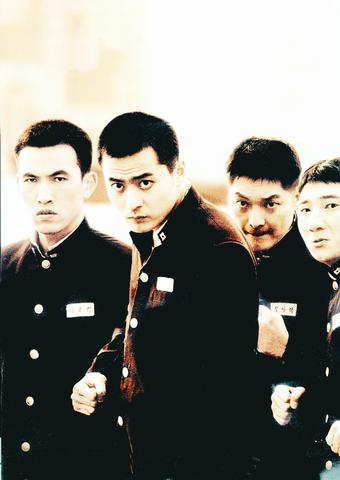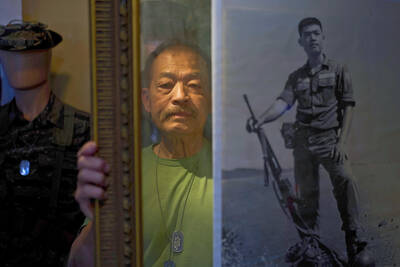Jan Dong-kun's new film Friend (Chin-gu) is like a large plate of spicy kimchi -- it's explosive and, in a way, uniquely Korean.
The film was a surprise blockbuster in Korea, selling over 8 million tickets this summer to audiences made up in large part of 30- to 40-year-old men, not the usual target demographic for a commercial feature film.

PHOTO: COURTESY OF SPRING INTERNATIONAL
But then, as its title suggests, this is a film about male bonding between four inseparable 13-year-old boys in the port city of Pusan in 1976.
One, Jeong-suk (Yoo Oh-sung), has a gang leader for a father; Dong-su (Jang Dong-kun) is the son of an undertaker; the diligent Sang-taek (Seo Tae-hwa) lives in a normal family; and Jeong-ho (Jeong Un-taek), a restless entertainer, has parents in the smuggling business.
The film is set at a time just before Korea's economic miracle of the 1980s. It was a time when students were forced to wear Japanese-influenced black uniforms and endured persistent and intense academic pressure as well as frequent corporal punishment.
The four boys in the film are rebels. They show up wherever they go with their collars open, sleeves rolled up and looking for fights. They smoke cigarettes on the school roof, and their favorite pastimes are to watch Bruce Lee movies and chase checker-skirted girls.
Twenty years pass, during which the four have gone in their different directions, but fate reunites them and poses a test to their friendship: Jeong-suk and Dong-su have become gang enemies, and both must kill the other to survive in their respective groups. Sang-taek and Jeong-ho can only sit at the sidelines and watch, pretending nothing has changed.
Friend is most successful in depicting the nostalgia for the 1970s. The director's beautiful photography, the classroom settings, the costumes, and the shots of Pusan blend seamlessly into the plot. In proper "guy flick" style, even the mass punch-ups are touching for their youthful, naive spirit. As the movie approaches its end, the plot gets more emotional as former friends confront each other knowing that the other is facing death. The violence then becomes more brutal and sensational.
The script, however, fails to explain the relationships between the four friends in sufficient detail, making their bonds a bit thin. The young and handsome Jang Dong-kun, who has a fanatical fan base in Taiwan, disappoints by posing too much as the typical bad boy rascal. Yoo Oh-sung, on the other hand, is more convincing as a conflicted killer.

As we live longer, our risk of cognitive impairment is increasing. How can we delay the onset of symptoms? Do we have to give up every indulgence or can small changes make a difference? We asked neurologists for tips on how to keep our brains healthy for life. TAKE CARE OF YOUR HEALTH “All of the sensible things that apply to bodily health apply to brain health,” says Suzanne O’Sullivan, a consultant in neurology at the National Hospital for Neurology and Neurosurgery in London, and the author of The Age of Diagnosis. “When you’re 20, you can get away with absolute

When the South Vietnamese capital of Saigon fell to the North Vietnamese forces 50 years ago this week, it prompted a mass exodus of some 2 million people — hundreds of thousands fleeing perilously on small boats across open water to escape the communist regime. Many ultimately settled in Southern California’s Orange County in an area now known as “Little Saigon,” not far from Marine Corps Base Camp Pendleton, where the first refugees were airlifted upon reaching the US. The diaspora now also has significant populations in Virginia, Texas and Washington state, as well as in countries including France and Australia.

On April 17, Chinese Nationalist Party (KMT) Chairman Eric Chu (朱立倫) launched a bold campaign to revive and revitalize the KMT base by calling for an impromptu rally at the Taipei prosecutor’s offices to protest recent arrests of KMT recall campaigners over allegations of forgery and fraud involving signatures of dead voters. The protest had no time to apply for permits and was illegal, but that played into the sense of opposition grievance at alleged weaponization of the judiciary by the Democratic Progressive Party (DPP) to “annihilate” the opposition parties. Blamed for faltering recall campaigns and faced with a KMT chair

A police station in the historic sailors’ quarter of the Belgian port of Antwerp is surrounded by sex workers’ neon-lit red-light windows. The station in the Villa Tinto complex is a symbol of the push to make sex work safer in Belgium, which boasts some of Europe’s most liberal laws — although there are still widespread abuses and exploitation. Since December, Belgium’s sex workers can access legal protections and labor rights, such as paid leave, like any other profession. They welcome the changes. “I’m not a victim, I chose to work here and I like what I’m doing,” said Kiana, 32, as she